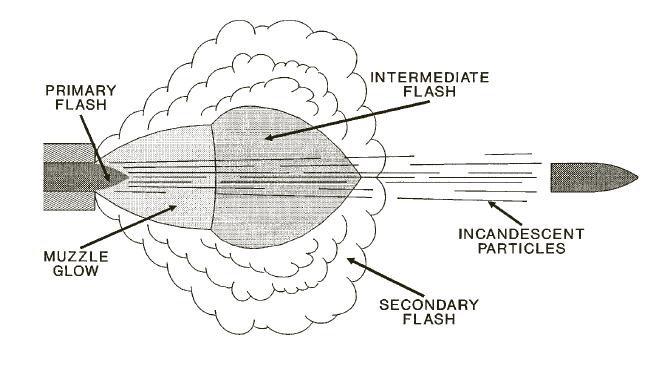HA, I knew I had this link...
Here is the anatomy of a flash (C-pher, that's GUN flash you pervert)
1) Muzzle Glow is usually a reddish white glow or tongue of flame at the muzzle that appears just prior to shot ejection and persists after shot ejection until the chamber pressure drops significantly. The initial glow is usually the result of hot, highly compressed gases (unburned propellants) leaking past the projectile driving band and is brightest in a worn gun. These gasses are hot enough to emit radiation in the visible light band. A "Cold Gun" with its lubricated barrel generally shows less muzzle glow than does a "Hot Gun" with its expanded barrel.
2) Primary Flash occurs after the projectile has exited the muzzle and is caused by those propellant gases exiting the muzzle behind the projectile. These are hot enough to emit large amounts of visible radiation but cool rapidly as they expand away from the muzzle.
3) Intermediate Flash consists of a reddish disc, slightly dished towards the gun, which appears about three inches (7.5 cm) from the muzzle of a small-caliber weapon and about 20-25 calibers from the muzzle for larger caliber weapons. Intermediate Flash occurs at the time of shot ejection and persists until the chamber pressure drops. It is brightest at the edge nearest the gun and gradually fades as the distance from the muzzle increases. This flash is due to a Mach shock wave created by the escaping gasses and projectile which, with its attendant pressure rise, causes the propellant gases to attain a temperature almost equal to the chamber temperature and so become self-luminescent.
4) Secondary Flash appears beyond the zone of the intermediate flash and is a rather ragged vortex of yellowish white flame. This is a result of the ignition of the combustible mixture of propellant gases and atmospheric oxygen caused by the turbulent mixing occurring at the boundary of the gas jet as it leaves the muzzle. The ignition of this mixture would appear to be initiated by its exposure to the high temperature of the intermediate flash.
5) Sparks are a common feature of the flash for small arms. These can arise from the ejection of incompletely burnt powder particles or by the ejection of white-hot acid or metallic particles. The former can be crystals of potassium salts if the powder is a "flashless" one while the latter can be the residual fragments of the metallic components of the cap composition or fragments of burning metal from the bullet jacket or driving bands.
Flash Suppressors attempt to stop the Intermediate and Secondary Flash from forming.
Hope that helps.


![Wink [wink] [wink]](/xen/styles/default/xenforo/smilies.vb/002.gif)
![Smile [smile] [smile]](/xen/styles/default/xenforo/smilies.vb/001.gif)